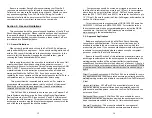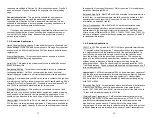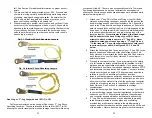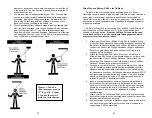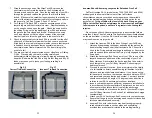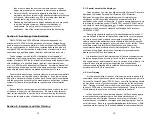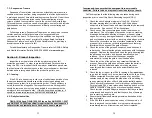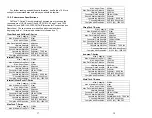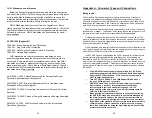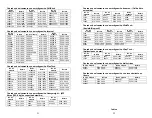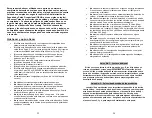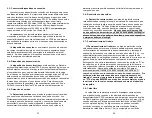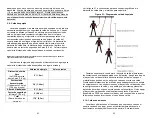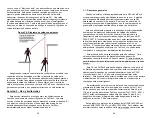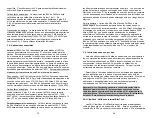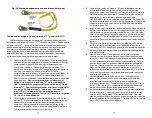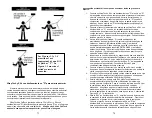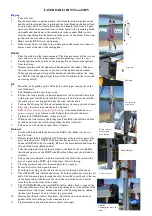
43
10-D: Standards and references
Below is a listing of standards that are applicable to the construction
and use of this product.
FallTech
strongly encourages that all employers
acquire and utilize these documents for the creation of your own fall
protection policies and your individual fall protection plans. Users of this
product should also be familiar with this information as well.
OSHA Standards bear the force of law on a federal level. Some
states have their own regulations which are locally enforced – check with
your State Department of Labor for specific requirements which may be
enforced in your area. OSHA Standards can be accessed for free at
www.osha.gov.
29 CFR 1926 (Subpart M)
1926.500: Scope, Application and Definitions
1926.501: Duty to Have Fall Protection
1926.502: Fall Protection Systems Criteria & Practices
1926.503: Training Requirements
ANSI standards are voluntary consensus standards, and are
generally regarded among the best practices where fall protection is
concerned. Some states have incorporated one or more of the ANSI
standards by reference, meaning that they may be enforced by some
state or local agencies. Check with your State Department of Labor for
further details. ANSI standards are available for purchase through the e-
standards store at www.ansi.org.
ANSI Z359.1-2007: Safety Requirements for Personal Fall Arrest
Systems, Subsystems and Components
ANSI Z359.2-2007: Minimum Requirements for a Comprehensive
Managed Fall Protection Program
ANSI Z359.12-2009: Connecting Components for Personal Fall Arrest
Systems
ANSI Z359.13-2009: Personal Energy Absorbers and Energy Absorbing
Lanyards
ANSI A10.32-2004: Fall Protection Systems for Construction and
Demolition Operations
44
Appendix A: Connector Types and Connections
Background
FallTech
offers Shock-Absorbing Lanyards with a wide variety of connector
options to help address the varied applications encountered on every jobsite.
Connectors can generally be classified as one of three basic types; snap hooks,
rebar hooks and carabiners. Each of these is a metal device with a mechanical
gate which is spring-loaded so as to close automatically.
Snap hook and rebar hook gates are supported by a latch, which is commonly
referred to as a “keeper”. The keeper is also spring-loaded and designed to lock
the gate in the closed position to prevent accidental disengagements.
Carabiner gates generally consist of an inner shaft and an outer barrel. The
barrel is rotated to unlock the inner shaft so that it can be opened. Both the inner
shaft and the outer barrel are spring-loaded so as to allow the gate to close and
lock automatically when released.
OSHA mandates on a federal level that all connectors used for fall arrest must
be of the locking type and that it must take two separate actions to open the gate.
All FallTech connectors meet this OSHA requirement.
In 2007, ANSI revised and published the Z359.1 standard for fall protection in
general industry and suggested that the gate strength on all connectors be
increased to 3,600 lbs. FallTech currently offers both the “old” style and “new”
style hooks to accommodate all users, some of whom have not elected to comply
with the voluntary ANSI standard. There are several important issues for users
and employers to consider with regard to how these standards have an effect on
the jobsite:
The ANSI Z359 standards apply to general industry. ANSI also
publishes standards for the Construction and Demolition industry
under the A10.32 designation – A10 does not presently require
3,600 lb gates on connectors.
Title 29 CFR 1910.66 App. C and 1926 Subpart M also do not
require 3,600 lb gates on connectors.
ANSI Z359 and A10 do not bear the force of law in most states –
Some states do, however, incorporate these standards by
reference within their own standards language. It is the
responsibility of the employer to know which standards may be
enforced in their work location(s).
Many government jobsites are required to use products meeting
the ANSI Z359 standards, particularly those that are managed by
the Army Corps of Engineers. Be aware of the requirements on
your jobsite if you are a government contractor or sub-contractor.
Regardless of the standard, all fall arrest products that are made to
comply with any of these standards is safe when used properly –
there is no substitute for doing the right thing regardless of which
product or products you select.

